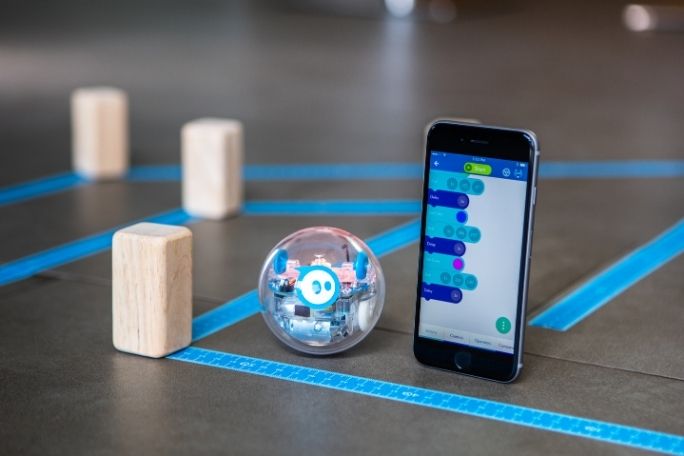Lesson summary
This is a STEAM lesson, which adds the Arts to STEM (Science, Technology, Engineering, and Mathematics). This lesson forms part of the Empathise phase of a Design Thinking unit focusing on robotics but can also be implemented as a stand-alone session. In this lesson, students learn about the history and use of robots and robotics. They then explore a robotic device, developing their understanding of how to manipulate it by experimenting with associated software.
Learning intentions:
Students will...
- understand the broad and undefined nature of the field of robotics
- have a general understanding of the history of robotics
- be familiar with programming techniques of a robotic device.
Success criteria:
Students can...
- explain what robotics is
- describe key developments in the history of robotics
- use an App to control a robotic device
- create a range of commands which control movement, sound and light
- explore different methods for giving commands.
Lesson guides and printables
Lesson details
Curriculum mapping
We encourage you to teach Learning Robotics both through and in-between disciplines (transdisciplinary).
The knowledge and skill developed through robotics requires the expertise of academic disciplines to be made sense of and explained in full. The best evidence from a wide range of disciplines presents the current best answers to our big questions.
Syllabus outcomes: MA3‑1WM, MA3‑2WM, MA3‑3WM, MA3‑5NA, MA3‑6NA, MA3‑8NA, MA3-9MG, MA3-10MG, MA3-11MG, MA3-12MG, MA3-16MG, MA3-17MG, EN3-1A, EN3-8D
General capabilities: Literacy, Numeracy, Digital Literacy, Critical and Creative Thinking, Personal and Social Capability.
Cross-curriculum priority: Sustainability.
Relevant parts of Year 5 and 6 Digital Technologies Achievement Standards: Students explain how the features of technologies influence design decisions and how digital systems are connected to form networks. Students describe a range of needs, opportunities or problems and define them in terms of functional requirements. They collect and validate data from a range of sources to assist in making judgements. Students generate and record design ideas for specified audiences using appropriate technical terms, and graphical and non-graphical representation techniques including algorithms. They plan, design, test, modify and create digital solutions that meet intended purposes including user interfaces and a visual program.
Relevant parts of Year 5 Mathematics Achievement Standards: Students solve simple problems involving the four operations using a range of strategies. They check the reasonableness of answers using estimation and rounding. Students identify and describe factors and multiples. They identify and explain strategies for finding unknown quantities in number sentences involving the four operations. Students continue patterns by adding and subtracting fractions and decimals. They use appropriate units of measurement for length, area, volume, capacity and mass, and calculate perimeter and area of rectangles. Students use a grid reference system to locate landmarks. They measure and construct different angles.
Relevant parts of Year 6 Mathematics Achievement Standards: Students solve problems involving all four operations with whole numbers. They solve problems involving the addition and subtraction of related fractions. Students connect decimal representations to the metric system and choose appropriate units of measurement to perform a calculation. They solve problems involving length and area. Students describe combinations of transformations. They solve problems using the properties of angles.
Relevant parts of Year 5 English Achievement Standards: Students listen and ask questions to clarify content. They develop and explain a point of view about a text, selecting information, ideas and images from a range of resources. They make presentations which include multimodal elements for defined purposes. They contribute actively to class and group discussions, taking into account other perspectives.
Relevant parts of Year 6 English Achievement Standards: Students compare and analyse information in different and complex texts, explaining literal and implied meaning. They select and use evidence from a text to explain their response to it. They listen to discussions, clarifying content and challenging others’ ideas. They show how specific details can be used to support a point of view. Students create detailed texts elaborating on key ideas for a range of purposes and audiences. They make presentations and contribute actively to class and group discussions, using a variety of strategies for effect.
Time required: 120 mins
Level of teacher scaffolding: Low – Much of this lesson involves exploration of and experimentation with robots. Students are encouraged to investigate independently and share their discoveries with each other to support others to develop skills and understandings.
Resources required
- device capable of displaying video to the class
- device capable of running Sphero Edu App, e.g. iPad, iPod Touch (or required software for your robot), one for each robot
- Sphero SPRK+ (or alternative programmable robot), minimum one per 3 students
- Student Worksheet (one copy per student)
- variety of reusable construction materials and additional equipment to create contexts/challenges for robots (e.g. Duplo, blocks, rulers, tennis balls, small hoops, etc.).
Skills
- collaboration
- communication
- community engagement
- creativity
- critical thinking
- digital literacy
- enterprise
- problem solving
- social skills.
Additional info
Level of teacher scaffolding: Low – Much of this lesson involves exploration of and experimentation with robots. Students are encouraged to investigate independently and share their discoveries with each other to support others to develop skills and understandings.
This is an original Cool+ lesson.


Welcome back!
Don't have an account yet?
Log in with:
Create your free Cool.org account.
Many of our resources are free, with an option to upgrade to Cool+ for premium content.
Already have an account?
Sign up with:
By signing up you accept Cool.org's Terms and Conditions(Opens in new tab) and Privacy Policy(Opens in new tab).